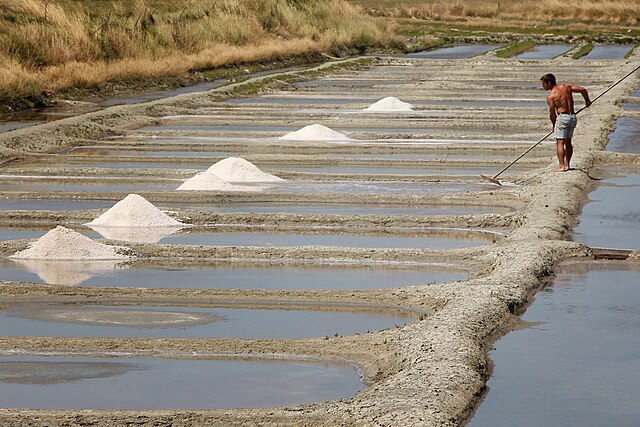 Image courtesy of Wikimedia commons
Image courtesy of Wikimedia commons
Meet the paludiers and discover the ancient craft of hand-harvested sea salt in Guérande, Noirmoutier, and Île de Ré.
A Summer Tradition Rooted in the Tides
When most people think of France in summer, they picture lavender fields, bustling beach towns, or rosé-fueled lunches on shaded terraces. But along the Atlantic coast, another time-honored tradition unfolds quietly with the rhythm of the tides: the annual salt harvest.
From July through early September, France’s paludiers—the skilled artisans of the salt marshes—collect fleur de sel and coarse grey sea salt by hand using techniques passed down for centuries.
For travelers seeking an authentic and meditative summer experience, visiting the salt marshes offers a rare glimpse into a living craft, shaped by nature and tradition.
What Is Fleur de Sel, and Why Is It So Special?
Fleur de sel (“flower of salt”) is the delicate, flaky crust of salt that forms naturally on the surface of shallow evaporation ponds when the conditions are just right: sun, breeze, and calm water. It’s skimmed off gently with wooden tools, usually at dusk, before sinking back into the water.
Unlike industrial salt, fleur de sel is prized for its complex flavor, crunchy texture, and mineral richness. Chefs and food lovers around the world consider it the caviar of sea salt.
Where to Experience Salt Harvest Season in France
1. Guérande: The Salt Capital of France
-
Location: Loire-Atlantique, near La Baule
-
Why Go: Guérande is the beating heart of France’s traditional salt production. Its sprawling marais salants (salt marshes) date back to medieval times and cover more than 2,000 hectares.
-
What to Do:
-
Take a guided tour with a paludier to watch salt harvesting in real time.
-
Visit the Maison des Paludiers to learn the history of salt production.
-
Shop for local fleur de sel, salted caramels, or “sel gris” (coarse grey salt) at the town market.
-
Insider Tip: Go around sunset for the most photogenic light—the salt ponds reflect the sky like mirrors.
2. Noirmoutier: Island Salt & Seaside Charm
-
Location: Vendée, accessible by bridge or tidal causeway
-
Why Go: This laid-back Atlantic island is famous for both its sea salt and potatoes—a beloved local pairing. The salt marshes of Noirmoutier are smaller and less touristy than Guérande but just as scenic.
-
What to Do:
-
Walk or bike along the saltern trails to observe paludiers at work.
-
Visit the Écomusée des Marais Salants for hands-on history.
-
Sample local specialties like butter with fleur de sel and freshly grilled seafood.
-
Bonus: Combine your visit with a swim at Plage des Dames or a seafood lunch in the harbor town of L’Herbaudière.
3. Île de Ré: Salt with a Splash of Style
-
Location: Charente-Maritime, connected to La Rochelle by bridge
-
Why Go: The chic island of Île de Ré balances rustic salt pans with boutique hotels, oyster shacks, and sandy beaches. The island’s salt marshes, known as les marais salants de Loix, are part of a landscape where salt, sea, and cycling go hand in hand.
-
What to Do:
-
Visit the Coopérative des Sauniers to meet local salt workers and buy direct from the source.
-
Take a bike tour through the marshes, stopping at traditional huts called cabanes.
-
Try salted caramel ice cream—a local favorite.
-
Tip: Many salt workers offer DIY workshops where you can try harvesting salt yourself.
A Craft Shaped by Patience and Weather
Harvesting salt is an art that depends entirely on the weather. Too much rain? No harvest. Too much wind? The delicate fleur de sel won’t form. It’s a process that teaches respect for nature’s timing and rhythms.
Paludiers use long wooden rakes called lousses to gently move the salt, and their daily work is a kind of choreography—quiet, repetitive, and meditative. Watching them is like seeing history preserved in motion.
What to Bring Home
-
Fleur de sel: For sprinkling on salads, grilled fish, or chocolate desserts.
-
Sel gris: Coarse salt for cooking or curing.
-
Artisanal salted butter or caramels: Local specialties in every salt-producing town.
-
Paludier ceramics or wooden salt spoons: Handmade souvenirs from the salt huts.
Final Thoughts: Slow Travel at Its Finest
Visiting France’s salt marshes in summer is about more than just seasoning your food—it’s about stepping into a centuries-old world where patience, sun, and sea come together to create something elemental.
So if you’re looking for a cooler, quieter alternative to beach crowds this July or August, consider wandering the salt trails of Guérande, Noirmoutier, or Île de Ré. You’ll leave with a new appreciation for life’s simplest (and saltiest) pleasures.